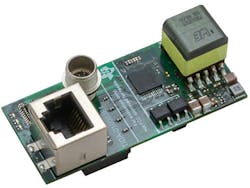Can you really drive a 400-W BLDC without a heatsink? How much more efficient can wireless charging get? And where should David Maliniak and Lee Goldberg get the beignets they'll be serving to readers during the meetup they’ll be holding at the APEC conference on March 17, in New Orleans?
Going to APEC? Join Us at the PowerBites Reader Meetup for Hot Coffee and Even Hotter Industry Gossip!
David Maliniak, Editor of Microwaves & RF, and I will be in the "Big Easy," covering the Applied Power Electronics Conference (APEC) conference from March 15-19. We decided it would be a great time to catch up with some of our readers over a cup of coffee and a beignet (our treat!). Reader meetups have been a great way to get our readers' take on the show, the state of the industry, and on the topics and technologies you want us to write about. In return, we'll dish any hot industry news we've got that's not prohibited by our NDAs!
The meetup is tentatively set to happen sometime on Tuesday afternoon, after the days' must-attend technical sessions are over. We’re still working to firm up a time and location, and we'll let you know as soon as we finalize the details. Meanwhile, please e-mail me to reserve your place and let us know how many beignets to order!
STMicro's Wireless-Charging IC Maximizes Power Transfer and Efficiency, Minimizes BOM
The STWLC68 family of highly integrated wireless-charging ICs delivers high performance and efficiency while reducing space requirements and solution costs for applications ranging from small wearables and appliances to larger devices, such as smartphones and tablets. It features a WPC Qi 1.2.4-compliant design that ensures its compatibility with all Qi-certified devices.
By integrating a fully integrated low-impedance, high-voltage synchronous rectifier and low dropout linear regulator, the STWLC68 achieves high efficiency and low power dissipation, critical for applications that are sensitive to heat buildup. All devices support customization of their firmware and platform parameters via an I2C interface.
Members of the STWLC68 family target applications ranging from under 2.5 W to 20 W. Two evaluation-boards are available to simplify prototyping for standard 5-W applications or 2.5-W low-power apps. The STWLC68JRH is in production and available in a 3.29- × 3.7- × 0.6-mm, 72-bump, 0.4-mm-pitch WLCSP, priced from $2 for orders of 10,000 pieces. Please visit www.st.com/stwlc68-pr for more information.
Power Integrations Expands BridgeSwitch BLDC Motor-Driver Range to 400 W
Power Integrations' BridgeSwitch integrated half-bridge (IHB) motor-driver IC now includes two new devices for higher-power applications requiring up to 400 W. These devices can drive single- or multi-phase high-voltage, synchronous or asynchronous motors, and support all popular MCU and motor-control algorithms. In brushless DC (BLDC) motor-drive applications, they deliver inverter efficiencies of up to 99.2%. The driver's package features a distributed thermal footprint that allows it to dissipate the small amount of remaining waste heat without the need for a heatsink.
The new 400-W BRD1167 and BRD1267 BridgeSwitch ICs are self-powered and deliver up to 1.33-A RMS, 11.5-A dc output peak current while retaining the same compact InSOP-24C surface-mount package used by lower-powered BridgeSwitch ICs. Like the rest of the BridgeSwitch family, they feature cycle-by-cycle hardware–based overcurrent, over/undervoltage, and overtemperature protection features that don't rely on a host controller. A robust single-wire preventive maintenance interface enables communication between the motor microcontroller and up to three BridgeSwitch devices.
Samples of BRD1167 and BRD1267 BridgeSwitch ICs, which will roll out in May 2020, are priced starting at $1.72 in 10,000-piece quantities. Technical support for the BridgeSwitch BLDC motor-drive family of ICs is available from the Power Integrations website at https://motor-driver.power.com/bridgeswitch.
TI Releases High-Density Isolated PoE/GigE Reference Design for Machine-Vision Cameras and Vision Sensors
As machine-vision cameras continue to shrink, low power consumption becomes ever-more essential. Power over Ethernet (PoE) offers an easy and reliable solution to combine power and data in one cable, achieving a high data rate and long reach. This reference design implements a complete PoE-powered device (PD), including a 1-Gb/s physical layer and a highly efficient, isolated power solution, in a very small form factor of 27 × 27 mm. Learn more at https://www.ti.com/tool/TIDA-010083.
MagnaChip's MOSFET Protects Wireless Earphones While Recharging
MagnaChip Semiconductor introduced a new MOSFET that’s specifically designed to enable wireless earphones to charge their batteries without danger of overcharging. It prevents damage to the wireless earphone charging case's delicate circuitry by blocking excessive voltage from flowing to the charger. It also protects the earphone charger against electrostatic discharges as high as 2 kV. The company says it expects to offer similar types of MOSFET products for wearable products such as smartwatches and VR (virtual reality) headsets. For more information, reach out to one of the sales offices listed in this link: https://www.magnachip.com/aboutus/aboutus_sub11.html.
When Shock isn’t an Option: Bourns' Isolation Power Transformers Ensure Safety in Medical, Industrial Apps
Bourns Inc. introduced its Model HCT series of high clearance/creepage distance isolation power transformers. These AEC-Q200-compliant, high-voltage isolation push-pull transformers are designed to support isolated interface power for CAN, RS-485, RS-422, RS-232, SPI, I2C, and lower-power LAN. They offer a simple way to provide isolated interface power for a broad range of applications, including low/medium risk medical sensors, communication PHYs, and metering equipment.
The Bourns Model HCT series features an input range of 3.3 to 5 V and delivers 3.3 to 15 V and up to 350-mA output, configured in a variety of turns ratios. The new series is constructed with a ferrite toroid core for high coupling factor and efficiency.
The transformers come in a low-profile 6.5-mm housing that offers reinforced insulation, at least 8-mm clearance/creepage distance, and 4.2 kV ac withstanding voltage to provide an elevated degree of isolation from high-voltage hazards. The HCT series transformers are compatible with spread-spectrum modulation for reduced emissions, and are compliant with IEC 60950-1, IEC 62368-1, IEC 60664-1 and AEC-Q200 standards.
Available now, the Bourns HCT high-voltage power transformer series is also RoHS-compliant. For additional product information, please visit https://www.bourns.com/docs/product-datasheets/hct.pdf.




